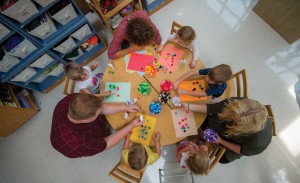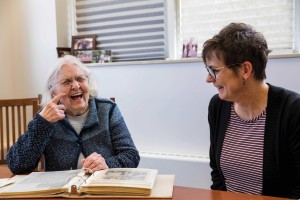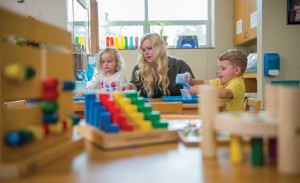Ninety years ago this past fall, the predecessor to today’s Fishback Center for Early Childhood Education took root in the first floor of East Men’s Hall with 16 children ages 3 to 5 in five rooms.
Today’s center, overseen by Professor Kay Cutler, serves 114 children ages 15 months through kindergarten in four spacious classrooms on the first floor of Pugsley Center.
The history of early childhood education at State can be traced to the home economics’ practice cottage established in January 1921 by Edith Pierson, who advertised for a home management baby. Baby Mary was the first of 10 children who lived in the cottage between January 1921 and June 1939.
Mary arrived at age 10 months after her mother died. She lived at South Dakota State College for two years before returning to Minneapolis to live with her father and six siblings.
The babies who followed Mary lived anywhere from a few quarters to three years at the cottage, which was a large white house north of the former East Men’s Hall on the corner of Medary and Harvey Dunn streets.
The nursery school was organized in fall 1928 in East Men’s Hall and operated simultaneously with the cottage until the cottage closed in June 1939. The nursery school, which had a kitchen, playroom, bathroom and office as well as a large backyard playground, was the first in the Dakotas, Montana and Wyoming.
In summer 1929, Helen Young was hired as director of the nursery school and professor of child development and family relations. She served the college for 34 years, many years as department head.

Kay Cutler, right, director of the Fishback Early Childhood Education Center, visits with Dona Thompson Fling during Fling’s visit in September.
Dona Thompson Fling remembers
Among the preschoolers in 1928 was Dona Thompson, who lived near campus and later would take violin lessons from renowned State music director Carl “Christy†Christensen. Now Dona Thompson Fling, 94, of Columbus, Ohio, was back on campus in September 2018 for a visit to the school where she also spent her first two years of college.
She remembers her preschool director, sitting at square tables for lunch and students not getting desserts if they misbehaved.
Most of her classmates were children of Brookings businessmen, medical professionals or faculty members, such as Albert Harding and Edward Binneweis, who like Young, are now remembered on campus for the buildings named after them.
Today,s preschool
Today’s students come from a variety of socioeconomic backgrounds. Selection into the program is considered quite a plum. There is a waiting list to get into the preschool and toddler labs, said Cutler, who has overseen the program since 1998.
In the toddler room there are 20 students—eight children ages 15 to 24 months attend Monday and Wednesday mornings, and 12 children ages 2 and 3 attend Tuesday and Thursday mornings. At ages 3 and 4, there is a morning and afternoon section of 17 students each. The 4- and 5-year-old section has 20 each for the morning and afternoon sessions.
The all-day kindergarten class, conducted in conjunction with the Brookings School District, has 20 students (capacity 22), Cutler said.
Program continually expands
Under Young’s leadership, a new major in child development was established and the curriculum was expanded. The Department of Child Development was formed in 1945.
In 1959, Ruth Kranzler joined the staff as another section of nursery school was added. In 1970, a second nursery school lab was created in the north wing of East Men’s Hall with three sections of nursery school being taught daily. In 1976, the vine-covered East Men’s Hall was razed as the department and nursery school moved into the former Pugsley Student Union.
The departmental offices occupied the space formerly dubbed the Jungle (cafeteria) with the preschool labs in the game room area.
The program, which was working with 35 to 45 students at East Men’s Hall, grew quickly. The program, which became known as SDSU Preschool with the move, was enrolling 100 students in five classrooms by the mid-1990s.
Updates at Pugsley
A series of renovation projects began in 1998.
Phase I, which involved a complete renovation of the three preschool classrooms and the adjoining observation booths, was completed in 1998. Phase II, completed in 2000, updated adjoining spaces—faculty offices, the kitchen, a classroom, the student resource room and the assessment room—as well as creating the Fishback Large Motor Laboratory.
The kindergarten room was created in 2004 with the renovation of the vacated Pugsley Studio Theater and also included four project rooms.
Tackled in 2007 was a 2,500-square-foot addition to create a gathering space and an art studio and to make the east entry to the Pugsley Center handicap accessible.
Cutler said the program provides hands-on training for 120 early childhood education majors annually, teaches children in an exploratory small-group setting, and presents opportunities for research, whether that be with furniture design, curriculum or child development.
From Baby Mary to preschoolers who have become nonagenarians and multiple generations since, the school has gotten many early learners started on the right foot.
– Dave Graves






